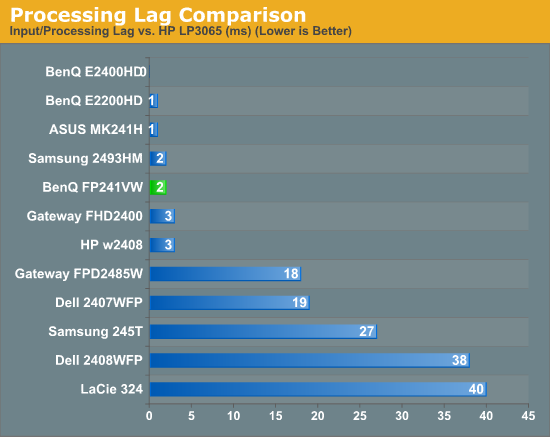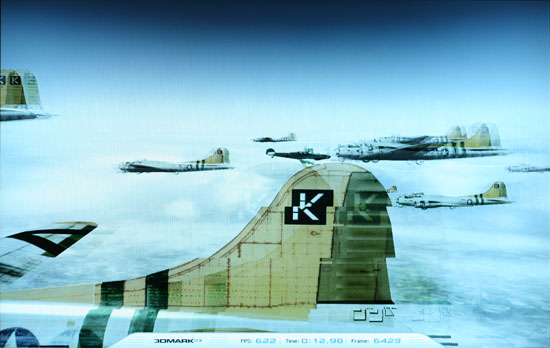Display Lag and Response Time
One of the areas where the A-MVA panel does extremely well is in the areas of display lag and pixel response time. Just to recap, you may have heard complaints about "input lag" on various LCDs, so that's one area we look at in our LCD reviews. We put input lag in quotation marks because while many people call it "input lag", the reality is that this lag occurs somewhere within the LCD panel circuitry, or perhaps even at the level of the liquid crystals. Where this lag occurs isn't the concern; instead, we just want to measure the duration of the lag. That's why we prefer to call it "processing lag" or "display lag".
To test for display lag, we run the Wings of Fury benchmark in 3DMark03, with the output set to the native LCD resolution - in this case 1920x1200. Our test system is a quad-core Q6600 running a Radeon HD 3870 on a Gigabyte GA-X38-DQ6 motherboard - we had to disable CrossFire support in order to output the content to both displays. We connect the test LCD and a reference LCD to two outputs from the Radeon 3870 and set the monitors to run in clone mode.
The reference Monitor is an HP LP3065, which we have found to be one of the best LCDs we currently possess in terms of not having display lag. (The lack of a built-in scaler probably has something to do with this.) While we know some of you would like us to compare performance to a CRT, that's not something we have around our offices anymore. Instead, we are looking at relative performance, and it's possible that the HP LP3065 has 20ms of lag compared to a good CRT - or maybe not. Either way, the relative lag is constant, so even if a CRT is faster at updating, we can at least see if an LCD is equal to or better than our reference display.
While the benchmark is looping, we snap a bunch of pictures of the two LCDs sitting side-by-side (using a relatively fast shutter speed). 3DMark03 shows the runtime with a resolution of 10ms at the bottom of the display, and we can use this to estimate whether a particular LCD has more or less processing lag than our reference LCD. We sort through the images and discard any where the times shown on the LCDs are not clearly legible, until we are left with 10 images for each test LCD. We record the difference in time relative to the HP LP3065 and average the 10 results to come up with an estimated processing lag value, with lower numbers being better. Negative numbers indicate a display is faster than the HP LP3065, while positive numbers mean the HP is faster and has less lag.
It's important to note that this is merely an estimate - whatever the reference monitor happens to be, there are some inherent limitations. For one, LCDs only refresh their display 60 times per second, so we cannot specifically measure anything less than approximately 17ms with 100% accuracy. Second, the two LCDs can have mismatched vertical synchronizations, so it's entirely possible to end up with a one frame difference on the time readout because of this. That's why we average the results of 10 images, and we are confident that our test procedure can at least show when there is a consistent lag/internal processing delay. Here is a summary of our results for the displays we have tested so far.
 |
| Display Input/Processing Lag vs. HP LP3065 | |||||||||||
| One | Two | Three | Four | Five | Six | Seven | Eight | Nine | Ten | Avg. (ms) | |
| ASUS MK241H | 10 | 0 | 0 | 0 | 0 | 0 | 0 | 0 | 0 | 0 | 1 |
| BenQ E2200HD | 0 | 0 | 0 | 10 | 0 | 0 | 0 | 0 | 0 | 0 | 1 |
| BenQ E2400HD | 0 | 0 | 0 | 10 | -10 | 0 | -10 | 0 | 0 | 10 | 0 |
| BenQ FP241VW | 0 | -10 | 0 | 10 | 0 | 10 | 0 | 0 | 10 | 0 | 2 |
| Dell 2407WFP | 10 | 20 | 30 | 20 | 10 | 10 | 30 | 30 | 10 | 20 | 19 |
| Dell 2408WFP | 30 | 40 | 40 | 40 | 30 | 30 | 40 | 30 | 50 | 50 | 38 |
| Gateway FHD2400 | -10 | -10 | 0 | 10 | 10 | 10 | 0 | 10 | 10 | 0 | 3 |
| Gateway FPD2485W | 30 | 10 | 20 | 20 | 20 | 10 | 0 | 30 | 20 | 20 | 18 |
| HP w2408 | 10 | 10 | 0 | 0 | 0 | 0 | 0 | 10 | 0 | 0 | 3 |
| LaCie 324 | 40 | 30 | 40 | 30 | 40 | 50 | 40 | 50 | 50 | 30 | 40 |
| Samsung 245T | 30 | 30 | 30 | 30 | 30 | 20 | 30 | 30 | 20 | 20 | 27 |
| Samsung 2493HM | 0 | 10 | 0 | 0 | 0 | 10 | 0 | -10 | 0 | 10 | 2 |

As you can see, all of the S-PVA panels we have tested to date show a significant amount of input lag, ranging from 20ms up to 40ms. In contrast, the TN and S-IPS panels show little to no processing lag (relative to the HP LP3065). The BenQ FP241VW performs similarly to the TN and IPS panels, with an average display lag of 2ms - not something you would actually notice compared to other LCDs. Obviously, if you're concerned with display lag at all, you'll want to avoid S-PVA panels for the time being. That's unfortunate, considering S-PVA panels perform very well in other areas.
 |
Despite what the manufacturers might advertise as their average pixel response time, we found most of the LCDs are basically equal in this area - they all show roughly a one frame "lag", which equates to a response time of around 16ms. In our experience, processing lag is far more of a concern than pixel response times. Taking a closer look at just the FP241VW, we can see the typical one frame lag in terms of pixel response time. However, the panel does appear to be a little faster in response time than some of the other panels we've tested (notice how the "ghost image" isn't as visible as on the HP LP3065), and we didn't see parts of three frames in any of the test images.
Update: What Causes Display Lag?
After the initial article went live, one of our readers who works in the display industry sent me an email. He provides some interesting information about the causes of image lag. Below is an (edited) excerpt from his email. (He wished to remain anonymous.)
PVA and MVA have inherent drawbacks with respect to LCD response time, especially gray-to-gray. To address this shortcoming, companies have invested in ASICs that perform a trick generically referred to as "overshoot." The liquid crystal (LC) material in *VA responds sluggishly to small voltage changes (a change from one gray level to another). To fix this, the ASIC does some image processing and basically applies an overvoltage to the electrodes of the affected pixel to spur the LC material into rapid movement. Eventually the correct settling voltage is applied to hold the pixel at the required level matching the input drive level.
It's very complicated math taking place in the ASIC in real time. It works well but with an important caveat: it requires a frame buffer. What this means is that as video comes into the panel, there is a memory device that can capture one whole video frame and hold it. After comparing it to the next incoming frame, the required overshoot calculations are made. Only then is the first captured frame released to the panel's timing controller, which is when the frame is rendered to the screen. As you may have already guessed, that causes at least one frame time worth of lag (17ms).
Some companies discovered some unintended artifacts in their overshoot calculations and the only way they saw to correct these was to allow for their algorithm to look ahead by two frames instead of one. So they had to up the memory of the frame buffer and now they started capturing and holding not one but two frames upon which they make their complex overshoot predictions to apply the corrected pixel drive levels and reduce gray-to-gray response time (at the expense of lag time). Again, it works very well for improving response time, but at the expense of causing lag, which gamers hate. That in a nutshell is the basis of around 33ms of the lag measured with S-PVA.
[End Excerpt - the following is not from our reader]
Not every display uses this approach, but this could account for the increase in display lag between earlier S-PVA and later S-PVA panels. It's also important to note that I tested the Dell 2408WFP revision A00, and apparently revision A01 does not have as much lag. I have not been able to confirm this personally, however. The above also suggest that displays designed to provide a higher image quality through various signal processing techniques could end up with more display lag caused by the microchip and microcode, which makes sense. Now all we need are better algorithms and technologies in order to reduce the need for all of this extra image processing -- or as we have seen with some displays (particularly HDTVs), the ability to disable the image processing.










114 Comments
View All Comments
JarredWalton - Wednesday, June 17, 2009 - link
The glossy vs. matte debate is one of those areas that comes down to personal preference. Me, I really dislike glossies - and I know plenty of others that feel the same. However, I also know people that prefer glossy displays. More power to 'em, but I'm not going to encourage the trend. :-)photoguru - Wednesday, June 17, 2009 - link
- Vizio 32" LCD Full HDTV (VO32LFHDTV10A) - $527 at Sam's Club USI've swapped out my 20" Apple Cinema Display for this 32" TV and I was completely shocked at the quality of the panel. If you run your image through one of the HDMI inputs text looks crisp and it even can run PIP for watching TV while working.
I am a creative director and so I spend a lot of time staring at screens working on print, web, and television programs... I would like to have an LED back lit screen but for the money this thing is ridiculous.
iwodo - Wednesday, June 17, 2009 - link
Are there any major different between panel type in terms of power consumption?And i really do hope either TN solve their "in-viewable" vertical viewing angle. ( Sorry "poor" in your article simply would not justify it ) with special coating that has been developed for a long time but there are yet wide spread of use.
Or E-IPS will give the best performance per dollar. TN is possible the worst invention for Display Monitor history in All times.
aceh0 - Wednesday, June 17, 2009 - link
The FP241VW launched in early 2007 and had nearly a two year run. Street pricing was under 500$ near the end of the product life cycle.
evilspoons - Wednesday, June 17, 2009 - link
I found an missing-box demo model at a local computer store for $250, but I passed on it seeing the noticable lag between moving the mouse and seeing the cursor respond. That, and the asinine stand, made me keep looking. I hate my 22" Gateway monitor (it does a terrible job dithering) but I'm not going to spend money on virtually the same thing as a replacement, either (i.e. any other new monitor).I tried to buy an IPS 24" HP monitor a few months ago (lp2475w) but the distributor I attempted to order from jacked the price up $200 (from $700 Canadian to nearly $900 - ouch) in the time between me placing the order and it shipping, so I just cancelled.
Then... I just gave up entirely because I realize I spend 99% of my computer time on my MacBook Pro now and I have to live with its LCD. Ha.
erple2 - Wednesday, June 17, 2009 - link
Why not just buy directly from hp? They have it for 729 Canadian dollars. Was it really that much cheaper when you got it from the distributor than directly from hp?JarredWalton - Wednesday, June 17, 2009 - link
Sorry for the error; I have clarified things now I hope. You're right that it first came out in 2007, but I believe it was announced early 2007 and actually available round about Sept/Oct. Anyway, it is discontinued, unfortunately just around the time the pricing was becoming desirable. You can find them online still at some places, but no major resellers carry them anymore so you'll have to take a bit of a chance if you buy one these days.IlllI - Wednesday, June 17, 2009 - link
"The vast majority of LCDs these days are TN panels, and the trend appears to be moving even more in that direction. With a soft economy, many are looking for any way to save money, and even those who really like quality displays may be willing to settle for a less expensive TN panel"while TN is indeed cheapest, you can actually get a 22in e-ips lcd for around (or sometimes under) $200. while not as good as the more expensive ips panels, it is (in my opinion) better quality than TN. certainly, you guys know of it? http://forums.anandtech.com/messageview.aspx?catid...">http://forums.anandtech.com/messageview.aspx?catid...
Grooveriding - Wednesday, June 17, 2009 - link
It's a real shame the tendency towards TN these days. Most consumers are just not informed as to the much more satisfying experience given by PVA/IPS panels.If you can get someone to sit in front of a TN and high quality monitor side by side that is usually enough to settle it, of course for some image quality is not a concern. For the enthusiast hardware user though, it usually is.
I have an older LG246WP-BN which is a fantastic screen with great quality as well as a Dell 2408. Reading this article has made me think my eyes are bad though, as I prefer the IQ on my LG to the Dell, which according to this review ought to be superior with it's more modern panel tech.
The0ne - Thursday, June 18, 2009 - link
Consumers are mostly going to want something average with a good low price. This isn't going to go away. And on most of their part they don't really care whether it's a TN panel or better because as long as it's "clear" and they like it then they'll buy it.I'll use myself as an example. I have 2 Dell 3007wfp-hc, 1 2407wfp, 2 22" viewsonics, 1 Acer 24" with TN, and 1 Acer 22" with TN. My main computer uses the 3007's of course but even when I switch to the other panels I rarely care. That's because the content I'm working with really doesn't require the extra 5-15% gamut, high contrast and so forth.
Now if I really really care about colors, brightness, details and what have you then sure I'll spend the extra money on better panels and features. But then again why wouldn't I spend it on the medical LCDs :)
I am pretty sure many of you commenting about wanting/needing a better than TN panel actually don't care whether you do or not on a daily basis. If you do you'll be a stickler like my co-worker who spends time paying attention to ghosting, blurs, etc EVERY time he uses his TV. I'm pretty sure many of you don't do this nor have the time to do this. If you do then....well, no comment. :)